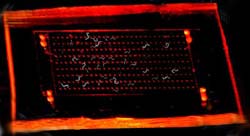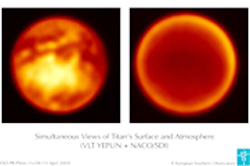
Organisms ranging from bacteria to humans navigate environments that can contain dangerously too little or too much oxygen. Yet, scientists know little about how animals sense oxygen levels around them.
Researchers from the Berkeley and San Francisco campuses of the University of California have now discovered how the nematode C. elegans senses oxygen levels in order to steer clear of surrounding areas that are too low or too high in oxygen.
In the process, the researchers also di

Research aimed at teasing apart the workings of RNA enzymes eventually may lead to ways of monitoring fat metabolism and might even assist in the search for signs of life on Mars, according to University of Michigan researcher Nils Walter. His latest work was published online in the Proceedings of the National Academy of Sciences June 24.
Walter and associates at U-M and colleague Xiaowei Zhuang and associates at Harvard University, use techniques that allow them to study single molecules
Discovery yields hope for universal treatment
Researchers at the University of Michigan, Johns Hopkins and the Institute of Bioinformatics in India have discovered a gene-expression “signature” common to distinct types of cancer, renewing hope that a universal treatment for the nation’s second leading killer might be found.
Scientists essentially abandoned the search for a common approach to cancer therapy after research launched by the 1970s “War on Cancer” revealed the

A University of Arizona astronomer and his collaborators are using a novel camera to hunt for extrasolar planets.
The project is being funded over the next five years by a $545,000 National Science Foundation award. NSF awarded the highly competitive Faculty Early Career Development (CAREER) grant to Associate Professor Laird M. Close. The CAREER program is a foundation-wide activity that offers the NSF’s most prestigious awards for new faculty members. The CAREER program recognizes
American students are happy to find jobs during the summer to help pay for their schooling. Others are more fortunate to be part of intern programs that prepare them for their eventual professional lives. For some others, however, the summer prospects are even more rewarding. How about an opportunity to construct carbon nanotubes in a Sydney, Australia laboratory? What about the chance to study with a molecular virologist in Taipei to search for a potential HIV cure? Or maybe do research based on a f

Even before marble-shaped pebbles nicknamed “blueberries” were discovered on Mars by the Opportunity rover, University of Utah geologists studied similar rocks in Utah’s national parks and predicted such stones would be found on the Red Planet.
In a study published in the June 17 issue of the journal Nature, the Utah researchers suggest both the Martian and Utah rocks – known as hematite concretions – formed underground when minerals precipitated from flowing groundwater.
“We came